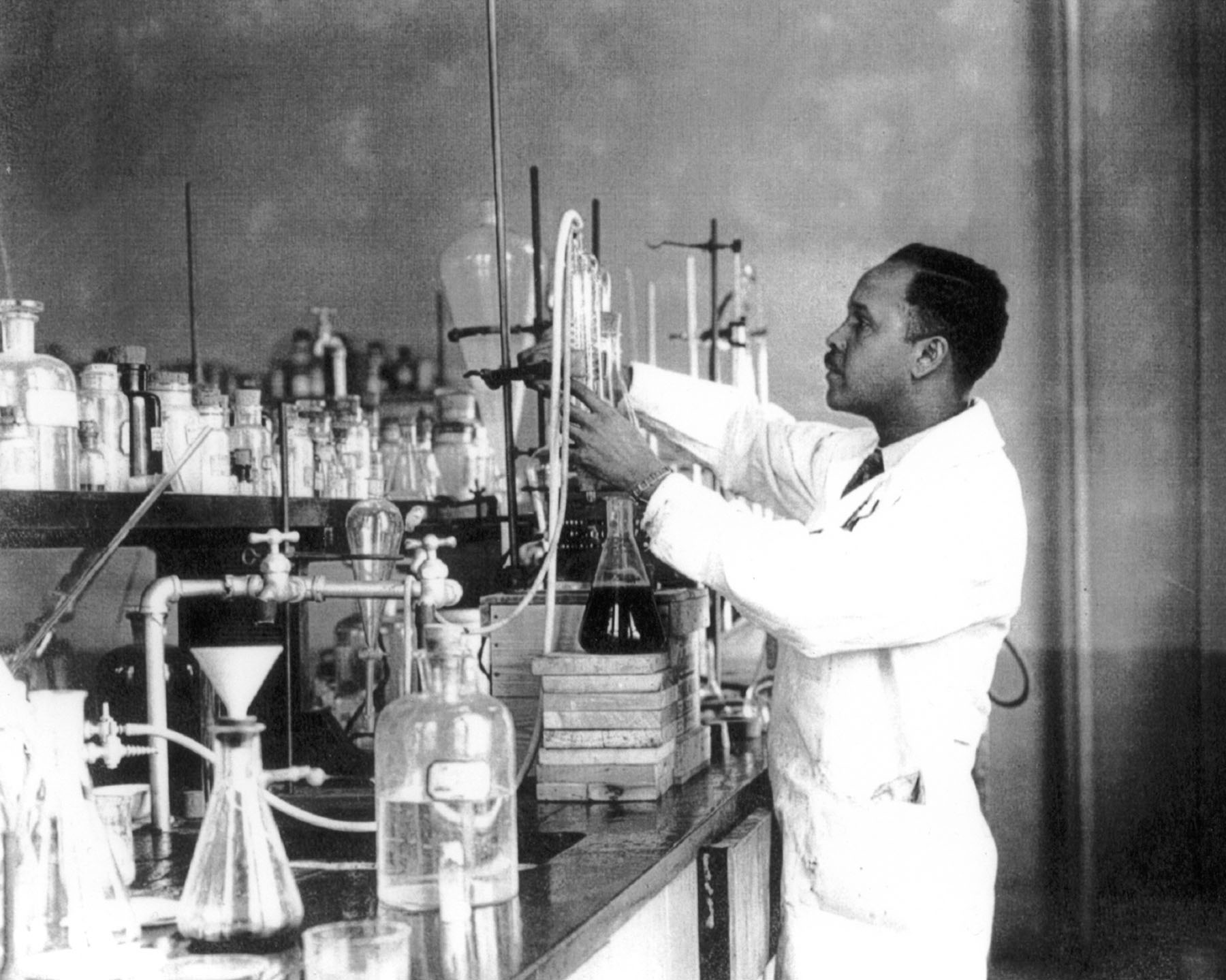
Imagine driving down a country road on a hot summer day, gazing out at fields of green, two-foot-tall plants. Chances are you’re enjoying the sight of a field of soybeans, one of Michigan’s top three crops. Did you ever wonder why farmers grow so much soy? Sure, tofu and soy milk are common foods but scientists have discovered soybeans can be used for “soy” much more.
Chemical Pioneer Percy Julian
One of those experimenting chemists was a Black American named Percy Julian. The grandson of former slaves, he simultaneously took his high school and college classes when he was studying at De Pauw University. Percy Julian earned his master’s degree in chemistry from Harvard but the university did not allow him to continue studying for his doctorate, leading him to earn his PhD from the University of Vienna in 1931.
In 1935, Dr. Julian attained world-wide recognition with his synthesis of physostygmine, but universities refused to make him a full professor and many chemical engineering firms would not hire him because of his race. Based on his discoveries, and to avoid the rampant discrimination he faced in the business and scientific world, he founded his own company to produce his products – and became one of America’s first Black millionaires.
Dr. Julian overcame great discrimination to become appointed to the National Academy of Sciences, the National Inventors Hall of Fame, and for his synthesis of physostygmine to be named one of the 25 Top Achievements in American Chemistry.
Phys-So-What-Now?
Physostygmine is a chemical that can treat glaucoma, an eye disease, and Dr. Julian discovered a way to use the calabar bean to produce this crucial medicine. Dr. Julian went on to use his chemical expertise to invent numerous medicines and safety products from the easy-to-grow soybean, improving and saving untold lives.
Learn more about Dr. Percy Julian, Black scientist and pioneer!
Inspired by Dr. Julian? Make your own discoveries at home!
Based on the discoveries of scientists like Percy Julian, there are tons of ways to explore the flexible chemical properties of the useful soybean at home. Make your own soybean discoveries in the comfort of your own kitchen!
Research Chemistry, Soybean-style
Before inventing new products, scientists explore and learn about the materials around them. For this simple experiement, all you need is a blender and some soybeans (dried or fresh).
Whizz up the soybeans, smoothie-style, pour into a clear glass, and let sit overnight. In the morning, examine the layers that have formed. What do you think they are made of? Hint: touch the top layer and wipe off on a paper napkin. That’s right – it’s soy oil! Soybeans are very high in fat for beans, making them a great plant-based source of oil (more on the usefulness of oil in the next experiment).
Once you’ve studied the layers, heat up a mug of water until boiling. Carefully pour the soy mixture into the hot water. What happens to your mixture? If you stir it, you might see some lumps appear. The proteins from the soybean have clumped together when they were heated up, similar to the process for making tofu. Soybeans are also very high in proteins, making them also a great plant-based source of protein for people and animals!
Invent the World with Soybeans
Remember the high oil content in soybeans? One of the most transformative materials of the last hundred years is plastic – and plastic is mostly made of oil. Imagine all the ways we use plastic today – packaging, medical supplies, food safety, and so much more. We can use renewable, plant-based soybean oil as the basis of these critical materials!
To make your own soy-based plastic, you’ll need a few household ingredients:
How to Make Your Own Bioplastic, courtesy of agclassroom.org:
Place 1 tablespoon of cornstarch into the plastic bag. (Figure 1)
Add 2 drops of soybean oil. (Figure 2)
Add 1 tablespoon of water. (Figure 3)
Close the bag and knead it with fingers, mixing the contents. (Figure 4)
Add 2 drops of food coloring. (Figure 5)
Seal the bag and mix remaining contents.
Open the bag slightly so it can vent.
Weigh the contents of the bag on a kitchen scale. (Figure 6)
Heat the bag in the microwave for 20-25 seconds. (Figure 7)
Remove the bag from the microwave and let the plastic cool. Caution: The bag and contents will be hot!
Weigh the contents of the bag again. (Figure 8) Compare the weight measurements from before and after microwaving. Did the ingredients transform into a chemically new material, or was it simply a physical mixture? Tip: if the before and after weights are different, that means a chemical change has occurred!
Once your bioplastic has cooled down a bit, see if you can mold it! How can you use your bioplastic to improve your life? How could scientists and businesses use this bioplastic technique to solve everyday problems and even change the world?
Register Now for Hope Summer Science Camps!
Love exploring our world, inside and out? Do we have a summer camp for you! Hope Summer Science Camps has over 20 years of experience giving kids the hands-on science explorations of your dreams. Check out the Science Camps page on our website for safety updates, camp schedule, and registration links. We are excited to see you this summer!